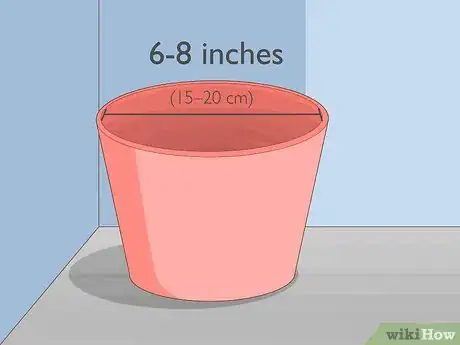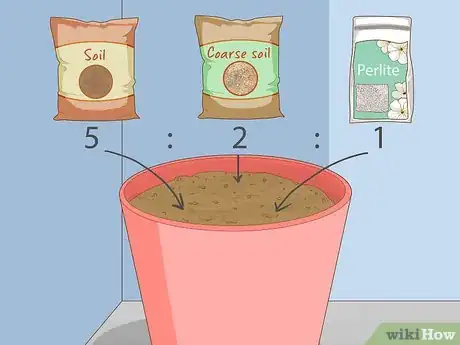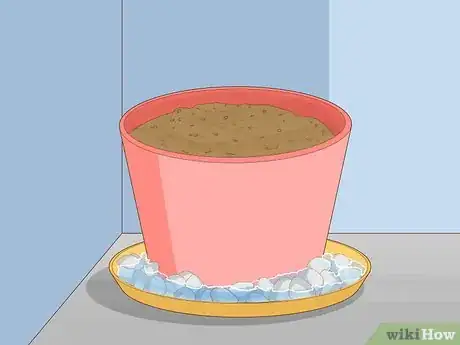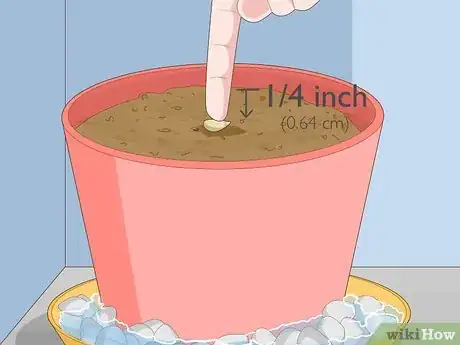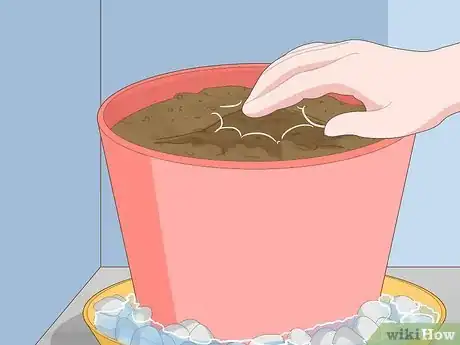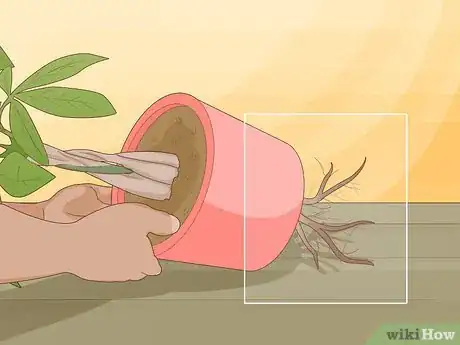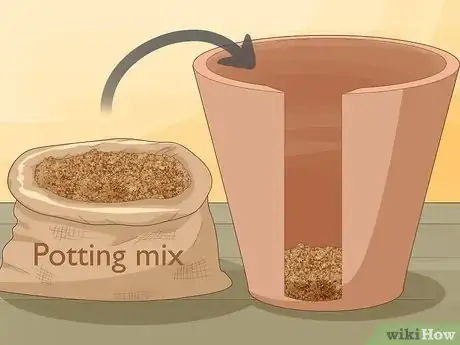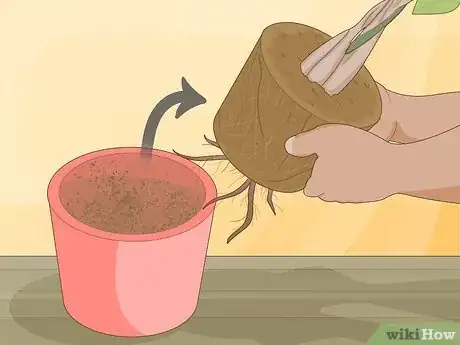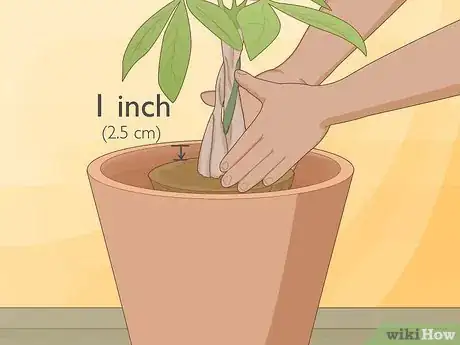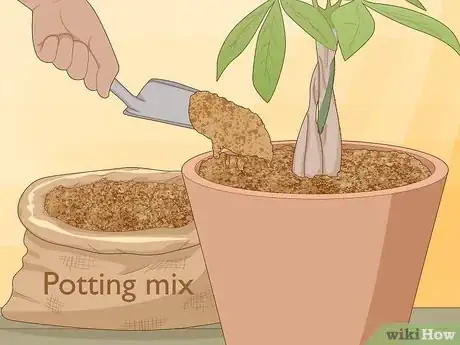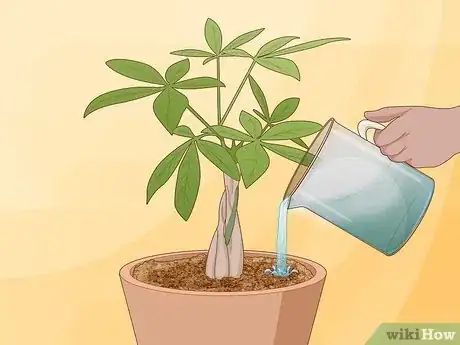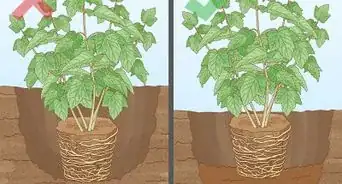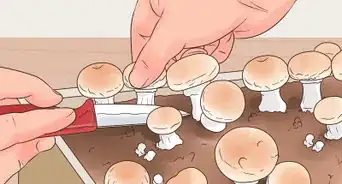This article was co-authored by wikiHow Staff. Our trained team of editors and researchers validate articles for accuracy and comprehensiveness. wikiHow's Content Management Team carefully monitors the work from our editorial staff to ensure that each article is backed by trusted research and meets our high quality standards.
There are 9 references cited in this article, which can be found at the bottom of the page.
This article has been viewed 11,223 times.
Learn more...
Money doesn’t grow on trees, as the old saying goes, but a money tree can grow inside your home. The tropical wetland plant, native to Central and South America, is more than just a fun name; some people believe it can bring luck and good fortune. On top of that, the plant requires minimal care, making it a popular choice for many households and offices. If you're feeling a little lucky (or just want a lovely, leafy plant), prepare your materials, plant or repot a money tree, and keep it healthy.
Steps
Choosing Plant Conditions
-
1Pick a bright, warm place to plant your money tree. These plants can thrive inside or outside as long as they have access to humidity and indirect light. However, too much sunlight can be deadly for the money tree; avoid placing them right in front of a window or in a backyard without shade.[1]
-
2Get a pot for your plant that is 6–8 inches (15–20 cm) wide. Even if you acquired your money tree in a pot, it’s smart to repot it. The plant is often sold in pots that are too small, which can stifle its growth.[4]
- If you're repotting a plant, you'll want a new pot that is about 2 inches (5.1 cm) larger than the first pot. If the pot is any bigger, the soil could become soggy, and soggy soil is deadly for a money tree. [5]
- Whether you're planting or repotting, your pot needs to have at least one drainage hole.
Advertisement -
3Add nutrient-rich potting mix to the pot. Money trees need soil that provides good drainage and nutrition. You can either make your own mix at home or purchase pre-mixed potting soil online or at a nursery.[6]
- To make your own nutrient-rich soil, mix 5 parts soil with 2 parts coarse sand and 1 part perlite, which is a non-organic additive found at any nursery.[7]
- If you want to purchase pre-mixed potting soil, a good choice is peat-moss-based soil, a popular option online and at nurseries. Flower soil and cactus soil also work well for the money tree.[8]
-
4Put your pot on a tray filled with small rocks and water. Unless you live in a tropical environment, the money tree can benefit from a little added humidity. This easy trick allows a bit of extra moisture to reach the plant.[9]
- The bottom of the pot should rest on the rocks, not on the water.
- If you have a humidifier, you can set this up near the pot instead.
Planting the Seed
-
1Press the seed into the soil with its pale end pointing sideways. The pale end is often called the "eye" of the seed. You'll want the seed to be approximately 1⁄4 inch (0.64 cm) down into the soil.[10]
- Never plant more than one money tree seed in a pot at a time. A money tree's roots need to be able to fill the pot.
-
2Lightly water the seed and soil. Consistency is key here. A money tree grows best when the soil around it is evenly moist, so take your time and avoid dumping water on the seed and the soil.
- As you water, you may notice that some of the soil moves over the seed. This is good. However, you'll want to stop if the seed the hole is in starts filling up with water.
- A watering can or a spray bottle great options for watering a money tree.
-
3Gently cover the seed with soil. The soil should be level, but avoid packing it down. You want to keep the soil light and airy. This is the best way for the money tree seed to receive enough nutrients and moisture from its surroundings.[11]
-
4Make sure the plant has consistent access to indirect light. While money trees need light, too much of it can be a bad thing. Direct sunlight is harmful to a money tree, but fluorescent light works well.
- The seed needs warm, moist soil to sprout. If you’re concerned it’s not getting enough heat, try using a seedling starting mat that can heat the soil up to eighty degrees. Once the seed sprouts, simply remove it from the mat.[12]
-
5Water the soil whenever the top layer dries out. During the first few days, check your money tree daily. You can test the dryness of the soil with your finger, but be careful not to disturb the seed.
- To check the dryness, press your finger into the soil near the rim of the pot.
- The money tree is ready for more water when the top layer of soil—roughly the top 1 inch (2.5 cm)—is dried out.
Repotting the Money Tree
-
1Keep an eye on how the roots are growing within your pot. Don't worry if your money tree seems to be outgrowing its pot; that's a sign of a healthy money tree. Most of them need be repotted every 2-3 years as they grow.[13]
- A good sign that your money tree needs a new pot is when the roots push against the sides and bottom of its existing pot.
-
2Put potting mix at the bottom of the new pot. You can make your own or buy a pre-mixed bag online or at nurseries. Fill only the bottom quarter of the pot. You may have to adjust this later based on the size of your money tree.[14]
- Make sure that the new pot is only slightly bigger than the last one. Money trees often die when placed in pots that are too large.
- When purchasing pre-mixed bags of soil, look for peat moss-based soil, flower soil, or cactus soil.[15]
-
3Turn the old pot upside down and tap the rim against a hard surface. When transplanting a plant, be as gentle as possible. Money trees can be sensitive to extreme movement and changes in environment.
-
4Slide the money tree's root ball out of the old pot. Do not grab the stem or the leaves of the money tree. It's better to break your pot than to break off any of the plant's stem or leaves.
- If you're having trouble loosening the root ball, you can use a knife to carefully cut the sides of the root ball loose from the pot.
- Use scissors to cut off any dead roots that are clinging to the root ball.
-
5Set the money tree into the new pot. You'll want the plant to sit about 1 inch (2.5 cm) beneath the rim of the pot. You may need to experiment with the levels of potting mix at the bottom of the pot to achieve this.
-
6Fill the rest of the pot with potting mix. Be careful to not pack in the soil too tightly. Money trees can sometimes experience shock when repotting, so you want to be as gentle as possible during this process.
Caring for the Plant
-
1Water the money tree whenever the soil gets dry. How often you water is completely dependent on the plant and its environment. Some money trees require watering once a week and others once a month.
- To avoid root rot, make sure you always dump out the drainage water that will accumulate in the tray underneath the pot.[16]
-
2Pay close attention to the color of the money tree’s leaves. This is one of the easiest ways to diagnose problems with your plant. If you check the leaves' colors at least one week, you'll be able to respond to any issues in time to save the plant from any serious health issues.
- Brown, crispy leaves often mean that the money tree is not getting enough water. Be a little more generous with the water and see if the leaves improve their color.[17]
- On the other hand, if your plant’s leaves are green, but drooping, you may be over-watering. Simply cut back on the frequency of your watering.[18]
- With yellow leaves, you should try either moving the plant to a more humid environment or adding fertilizer.[19]
-
3Add fertilizer every two weeks, but hold off during the winter months. Growth slows down for the money tree when the light levels are lower, and too much fertilizer could actually be harmful to its health.[20]
- There are a variety of fertilizers that work well for money trees. While liquid fertilizer is a popular option, you can also use bonsai fertilizer pellets, available online or at most nurseries.[21]
-
4Use sharp gardening shears to prune your money tree. A money tree does not require trimming, but, if left unchecked, the plant could easily outgrow the place you've put it. If you don't want to keep moving your money tree to areas that can accommodate its increasing size, prune it at least once every spring and summer.[22]
- To discourage new growth, pinch off the light green growing tips at the end of branches.[23]
- Remove any brown, damaged, or wilted leaves. This will improve the overall appearance of the money tree's health.
- Do not be too discouraged if you "over prune" your money tree. The leaves grow back quickly.[24]
-
5Adjust the money tree's location, depending on the temperature. If your plant has been thriving outdoors, remember to think about the weather as the seasons change. You can always bring the plant indoors during the colder months.
- Move the plant away from AC vents, heaters, and drafty entryways or windows.Your money tree grows best when its environment is as undisturbed as possible.[25]
References
- ↑ https://www.apartmenttherapy.com/money-tree-plants-our-best-tips-for-growing-and-care-239893
- ↑ https://www.epicgardening.com/money-tree-plant/
- ↑ http://www.missouribotanicalgarden.org/PlantFinder/PlantFinderDetails.aspx?taxonid=277941
- ↑ https://www.epicgardening.com/money-tree-plant/
- ↑ https://www.epicgardening.com/money-tree-plant/
- ↑ https://www.greenandvibrant.com/money-tree-plant
- ↑ https://www.greenandvibrant.com/money-tree-plant
- ↑ https://www.greenandvibrant.com/money-tree-plant
- ↑ https://www.apartmenttherapy.com/money-tree-plants-our-best-tips-for-growing-and-care-239893
- ↑ https://www.epicgardening.com/money-tree-plant/
- ↑ https://www.bonsaioutlet.com/money-tree-care/
- ↑ https://www.epicgardening.com/money-tree-plant/
- ↑ https://www.epicgardening.com/money-tree-plant/
- ↑ https://www.greenandvibrant.com/money-tree-plant
- ↑ https://www.greenandvibrant.com/money-tree-plant
- ↑ https://www.apartmenttherapy.com/money-tree-plants-our-best-tips-for-growing-and-care-239893
- ↑ https://www.epicgardening.com/money-tree-plant/
- ↑ https://www.epicgardening.com/money-tree-plant/
- ↑ https://www.epicgardening.com/money-tree-plant/
- ↑ https://www.guide-to-houseplants.com/money-tree-plant.html
- ↑ https://getbusygardening.com/money-plant-care/#money-plant-fertilizer
- ↑ https://getbusygardening.com/money-plant-care/#money-plant-pruning
- ↑ https://www.guide-to-houseplants.com/money-tree-plant.html
- ↑ https://getbusygardening.com/money-plant-care/#money-plant-pruning
- ↑ https://www.guide-to-houseplants.com/money-tree-plant.html
- ↑ https://www.salvatoremanzi.com/moneytree/

